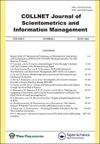Applications of microfluidic technology in food sector: A bibliometric analysis
IF 0.8
Q2 INFORMATION SCIENCE & LIBRARY SCIENCE
COLLNET Journal of Scientometrics and Information Management
Pub Date : 2021-11-22
DOI:10.1080/09737766.2021.1989989
引用次数: 1
Abstract
Over the past few years, microfluidic technology has gained significant attention because of its miniaturized system and provides several advantages over a conventional macroscale system. The purpose of the present study is to identify the global research trends of the applications of microfluidics in food analysis and processing. The data mining was performed using the search keywords “Microfluidics OR microfluidic” AND food (TITLE-ABS-KEY) which resulted in 745 documents after the evaluation and filtration for relevant documents based on the Scopus database. Out of this, 478 (64.16 %) were articles, 140 (18.8 %) were review papers, conference papers (95, 12.75 %), book chapters (26, 3.49 %), and others (6, 0.8 %). The record indicated that the first document in food microfluidics was published in 2003. It was observed that 72.08 % of the documents have been published in the last 6 years (20152020). China and the United States were the most productive countries in food microfluidics research during the period of assessment. Purdue University was the leading organization with 31 documents and 816 total citations. Yanbin Li was found to be the most prolific author with 20 publications. The analysis demonstrated that Biosensors and Bioelectronics and Lab on a Chip were the most active journals in terms of the number of publications and citations, respectively. This study showed that the application of microfluidics in the food sector is relatively new and the field is still in the developing stage. It is anticipated that intensive research activities will be carried out worldwide.微流体技术在食品领域的应用:文献计量学分析
在过去的几年里,微流控技术因其系统的小型化和与传统的宏观系统相比的一些优点而受到了极大的关注。本研究的目的是确定微流体在食品分析和加工中的应用的全球研究趋势。利用检索关键词“Microfluidics OR microfluidic”和food (TITLE-ABS-KEY)进行数据挖掘,基于Scopus数据库对相关文献进行评估和筛选,得到745篇文献。其中,论文478篇(64.16%),综述论文140篇(18.8%),会议论文95篇(12.75%),图书章节26篇(3.49%),其他6篇(0.8%)。记录显示,第一份关于食品微流体的文件发表于2003年。72.08%的文献发表于最近6年(2015 - 2020年)。在评估期间,中国和美国是食品微流体研究成果最多的国家。普渡大学以31篇文献和816次引用位居榜首。李彦斌是最多产的作家,发表了20篇论文。分析表明,《生物传感器》、《生物电子学》和《芯片上的实验室》分别是发表次数和引用次数最多的期刊。该研究表明,微流体技术在食品领域的应用相对较新,尚处于发展阶段。预计将在世界范围内开展密集的研究活动。
本文章由计算机程序翻译,如有差异,请以英文原文为准。
求助全文
约1分钟内获得全文
求助全文
来源期刊

COLLNET Journal of Scientometrics and Information Management
INFORMATION SCIENCE & LIBRARY SCIENCE-
自引率
0.00%
发文量
11
 求助内容:
求助内容: 应助结果提醒方式:
应助结果提醒方式:


